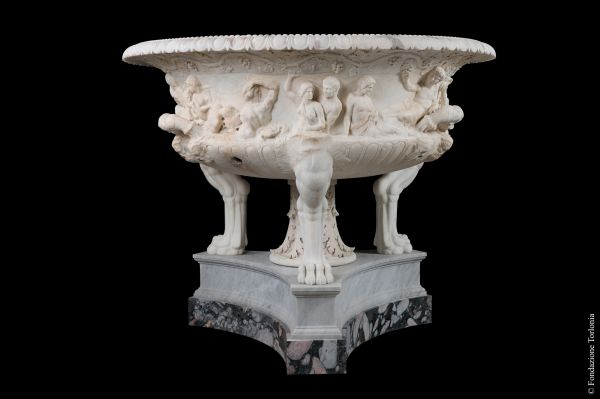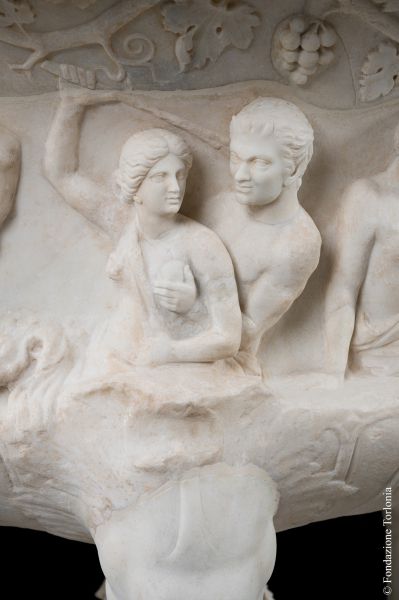


Cesi Torlonia Cup, Crater with Bacchic symposium, known as the Cesi Cup or Torlonia Vase
The Cesi Torlonia Cup tells its long history through the prestigious places that have hosted it. The crater, which has an elegantly sculpted frieze decorated with scenes from a Bacchic symposium, resting on lion paws, was conceived in ancient times as a sumptuous furnishing element and probably comes from the horti of Agrippina, the great complex of buildings and private gardens of Agrippina the Elder, mother of the Emperor Caligula. In the horti, which extended from the northernmost end of the Janiculum to the Vatican Plain, it was used as a fountain, together with a statue of Silenus spouting water. The precious vase, probably already placed in the Middle Ages in front of one of the churches of Trastevere, never lost its ornamental function; in the sixteenth century it became part of the Cesi Collection, and in the eighteenth century part of the Albani Collection. Situated within the frame of Villa Albani, where it underwent further restoration work after the acquisition of the monumental complex by Prince Alessandro Torlonia, it became part of the Family Collection and later of the Torlonia Museum.
Inventory: MT 297
Material: White marble
Technique: Work sculpted through the use of: chisels (also square-tipped and toothed) rasps
Dating: Imperial era
Origin: Church of Santa Cecilia in Trastevere or that of San Francesco a Ripa (end of 15th c.), Villa Cesi (first half of 16th c.), Villa Albani (at least since 1760).
The Cesi Torlonia Cup tells its long history through the prestigious places that have hosted it. The crater, which has an elegantly sculpted frieze decorated with scenes from a Bacchic symposium, resting on lion paws, was conceived in ancient times as a sumptuous furnishing element and probably comes from the horti of Agrippina, the great complex of buildings and private gardens of Agrippina the Elder, mother of the Emperor Caligula. In the horti, which extended from the northernmost end of the Janiculum to the Vatican Plain, it was used as a fountain, together with a statue of Silenus spouting water. The precious vase, probably already placed in the Middle Ages in front of one of the churches of Trastevere, never lost its ornamental function; in the sixteenth century it became part of the Cesi Collection, and in the eighteenth century part of the Albani Collection. Situated within the frame of Villa Albani, where it underwent further restoration work after the acquisition of the monumental complex by Prince Alessandro Torlonia, it became part of the Family Collection and later of the Torlonia Museum.
Inventory: MT 297
Material: White marble
Technique: Work sculpted through the use of: chisels (also square-tipped and toothed) rasps
Dating: Imperial era
Origin: Church of Santa Cecilia in Trastevere or that of San Francesco a Ripa (end of 15th c.), Villa Cesi (first half of 16th c.), Villa Albani (at least since 1760).


